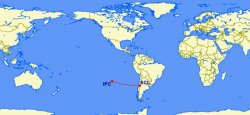Hi
In regards to flights from Australia to Honolulu, assuming the weather is bad and you can not land on another island . Where would you divert too ?
Also with diversions,during the flight, do you dicuss the options when you get a change in information or only when it may impact the flight ? For example things such as weather updates at the destination.
In regards to flights from Australia to Honolulu, assuming the weather is bad and you can not land on another island . Where would you divert too ?
Also with diversions,during the flight, do you dicuss the options when you get a change in information or only when it may impact the flight ? For example things such as weather updates at the destination.















